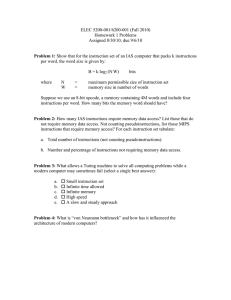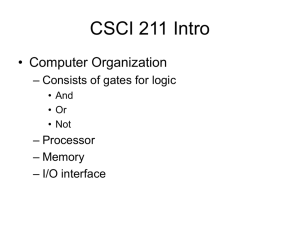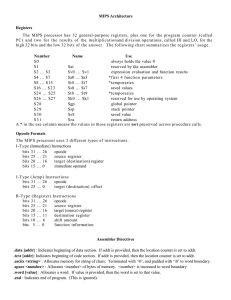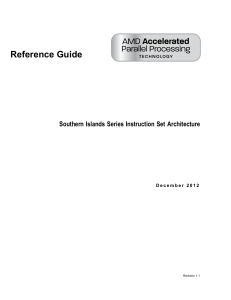The DLX Processor Architecture
advertisement
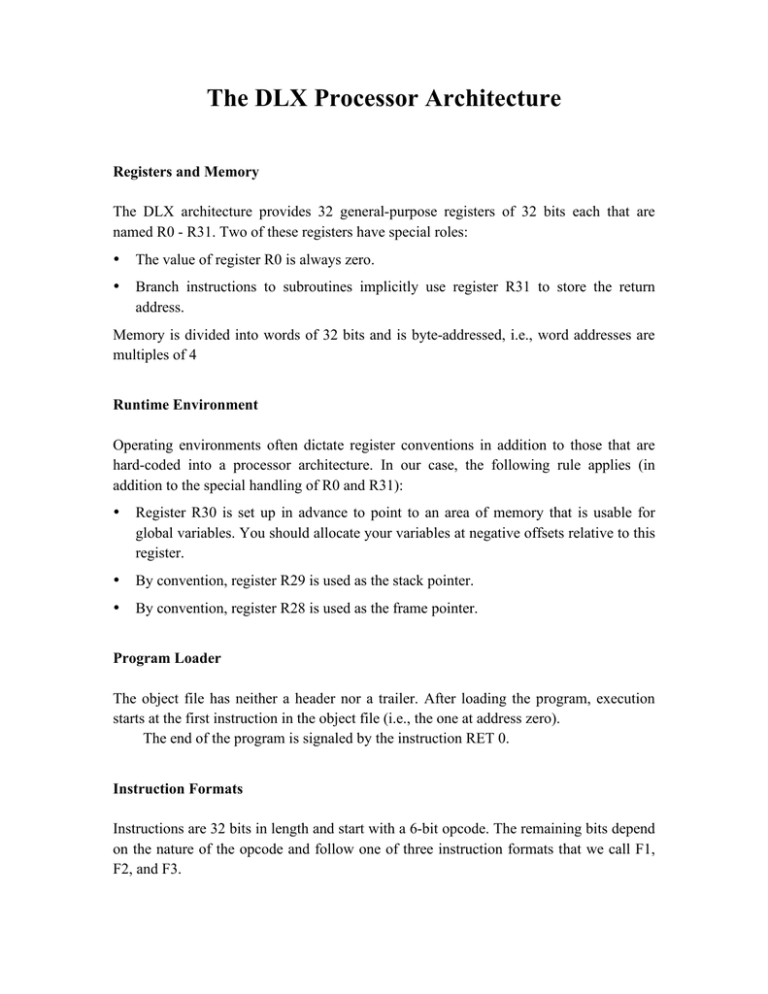
The DLX Processor Architecture Registers and Memory The DLX architecture provides 32 general-purpose registers of 32 bits each that are named R0 - R31. Two of these registers have special roles: • The value of register R0 is always zero. • Branch instructions to subroutines implicitly use register R31 to store the return address. Memory is divided into words of 32 bits and is byte-addressed, i.e., word addresses are multiples of 4 Runtime Environment Operating environments often dictate register conventions in addition to those that are hard-coded into a processor architecture. In our case, the following rule applies (in addition to the special handling of R0 and R31): • Register R30 is set up in advance to point to an area of memory that is usable for global variables. You should allocate your variables at negative offsets relative to this register. • By convention, register R29 is used as the stack pointer. • By convention, register R28 is used as the frame pointer. Program Loader The object file has neither a header nor a trailer. After loading the program, execution starts at the first instruction in the object file (i.e., the one at address zero). The end of the program is signaled by the instruction RET 0. Instruction Formats Instructions are 32 bits in length and start with a 6-bit opcode. The remaining bits depend on the nature of the opcode and follow one of three instruction formats that we call F1, F2, and F3. 2 F1 F2 F3 6 5 5 16 op a b c 6 5 5 op a b 11 5 c 6 26 op c Arithmetic Instructions Arithmetic instructions come in two variants: A variant in which one of the operands is a constant value directly encoded in the opcode (“immediate operand”) and a variant in which both operands are contained in registers. The result of the operation is always deposited in a register. For the two shift instructions, a positive shift count denotes a shift to the left, and a negative count a shift to the right. Mnemonic ADD a, b, c SUB a, b, c MUL a, b, c DIV a, b, c MOD a, b, c CMP a, b, c OR a, b, c AND a, b, c BIC a, b, c XOR a, b, c Operation R.a := R.b + R.c R.a := R.b - R.c R.a := R.b * R.c R.a := R.b DIV R.c R.a := R.b MOD R.c R.a := sign(R.b – R.c) without over/underflow R.a := R.b OR R.c R.a := R.b AND R.c R.a := R.b AND (NOT R.c) R.a := R.b XOR R.c Fmt/Opcode F2 0 F2 1 F2 2 F2 3 F2 4 F2 5 F2 8 F2 9 F2 10 F2 11 LSH ASH a, b, c a, b, c R.a := logical shift of R.b by count R.c R.a := arithmetic shift of R.b by count R.c F2 F2 12 13 CHK a, c halt if (R.a < 0) or (R.a >= R.c) F2 14 3 The CHK instruction is useful for testing the validity of an array index. Execution is aborted if the check fails. The immediate variants of the instructions use instruction format F1. The 16-bit quantity labelled “c” in the opcode is sign-extended to 32 bits before it is applied to the operation. Mnemonic ADDI a, b, c SUBI a, b, c MULI a, b, c DIVI a, b, c MODI a, b, c CMPI a, b, c ORI a, b, c ANDI a, b, c BICI a, b, c XORI a, b, c Operation R.a := R.b + c R.a := R.b - c R.a := R.b * c R.a := R.b DIV c R.a := R.b MOD c R.a := sign(R.b – c) without over/underflow R.a := R.b OR c R.a := R.b AND c R.a := R.b AND (NOT c) R.a := R.b XOR c Fmt/Opcode F1 16 F1 17 F1 18 F1 19 F1 20 F1 21 F1 24 F1 25 F1 26 F1 27 LSHI ASHI a, b, c a, b, c R.a := logical shift of R.b by count c R.a := arithmetic shift of R.b by count c F1 F1 28 29 CHKI a, c halt if (R.a < 0) or (R.a >= c) F1 30 Note that the opcode of an “immediate” instruction can be calculated from the opcode of a “register” instruction by adding 16. Load/store Instructions Load/Store instructions use formats F1 for “base register plus displacement” and F2 for “indexed” addressing. In the case of a constant displacement, the 16-bit quantity labelled “c” in the opcode is sign-extended to 32 bits. In the “indexed” case, the contents of a both base registers are added to form the effective address. Mnemonic LDW a, b, c LDX a, b, c POP a, b, c STW a, b, c STX a, b, c PSH a, b, c Operation R.a := Mem[R.b + c] R.a := Mem[R.b + R.c] R.a := Mem[R.b]; R.b := R.b + c Mem[R.b + c] := R.a Mem[R.b + R.c] := R.a R.b := R.b + c; Mem[R.b] := R.a Fmt/Opcode F1 32 F2 33 F1 34 F1 36 F2 37 F1 38 4 Control instructions Mnemonic BEQ a, c BNE a, c BLT a, c BGE a, c BLE a, c BGT a, c Operation branch to c if R.a = 0 branch to c if R.a <> 0 branch to c if R.a < 0 branch to c if R.a >= 0 branch to c if R.a <= 0 branch to c if R.a > 0 BSR JSR RET save PC in R31, then branch to 4*c (PC-relative) F1 save PC in R31, then jump to c (absolute) F3 jump to address in R.c, end program if c=0 F2 c c c Fmt/Opcode F1 40 F1 41 F1 42 F1 43 F1 44 F1 45 46 48 49 Branch means: jump from the current position forward (if c > 0) or backward (if c < 0) by c instructions (words). Since instructions can only begin at a word boundary, it makes sense giving the offset in words rather than in Bytes, as this increases the range of the jump by a factor of four. Jump means: go to an absolute address. Here, the address is given as a Byte address, and not as a word address. Input/Output Instructions Mnemonic RDD a WRD b WRH b WRL Operation R.a := read a decimal number from the input write the contents of R.b to the output in decimal write the contents of R.b in hexadecimal start a new line on the output Fmt/Opcode F2 50 F2 51 F2 52 F1 53
